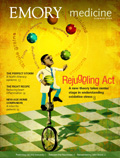Out of this world

Smith Johnston 81M
His patients are from outer space. But they are of the human form, and on returning to Earth, they find Smith Johnston 81M waiting for them.
A medical officer and flight surgeon for NASA at the Johnson Space Center in Houston, Johnston is one of the top guys responsible for astronauts’ health—before, during, and after flights. He has to make sure that any flight candidate is healthy enough to withstand the immense physical toll on the body caused by weightlessness in outer space.
“We take the healthiest people in the world and put them in one of the most hazardous environments,” says Johnston. “I think of myself as running the ultimate preventive medicine clinic.”
When a space shuttle is in flight, Johnston sits in mission control to monitor the astronauts during their awake hours. (No easy feat since it takes two years to become certified to sit in mission control.) Astronauts lose 1% to 2% of their bone mass each month and 15% of their blood volume during a mission. Kidney stones are a common problem, as are skin rashes from the lack of showering. (Astronauts also have to swallow their toothpaste.) They often face decompression sickness after space walks and upon their return to Earth.
Johnston developed screening standards for scientists to work at the South Pole for the National Science Foundation. Conditions are so extreme eight months of the year that no one can be evacuated should a medical emergency occur. Workers there also suffer sleep disturbances and vitamin D deficiencies, as the sun never rises for many months of the year.
The flight surgeon has worked in a number of places, including Russia and Kazakhstan, where the front end of a space capsule overheated and caused a huge brush fire upon landing. “We thought we had lost the astronauts, but luckily they were okay,” Johnston says.
The Kazakhstan incident brought to mind the seven astronauts who died aboard the Columbia space shuttle, which disintegrated on its return to Texas in 2003. Johnston recently traveled to Israel to observe the February 1st anniversary of the death of Ilan Ramon, the first Israeli astronaut, who was aboard the flight.
Despite the risks, Johnston would serve as an astronaut on a mission, given the opportunity. “But it’s a young person’s game,” he says. He looks forward to the day when the Orion, a new Apollo-shaped craft for lunar travel, replaces the space shuttle in about 2015 and when astronauts travel to Mars (at least a year’s trip to and from the planet).
For a medical school graduate who seemed to like every specialty, Johnston found the right one. After completing a residency at the NASA-sponsored aerospace medicine program at Wright University in Ohio, he joined the Johnson Space Center in 1991.—Kay Torrance


